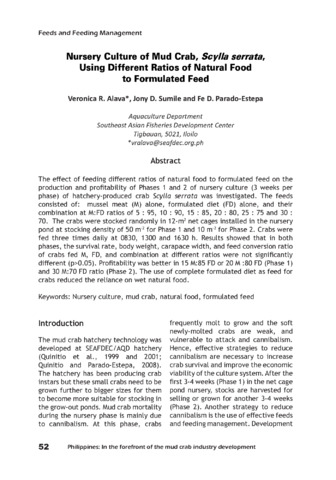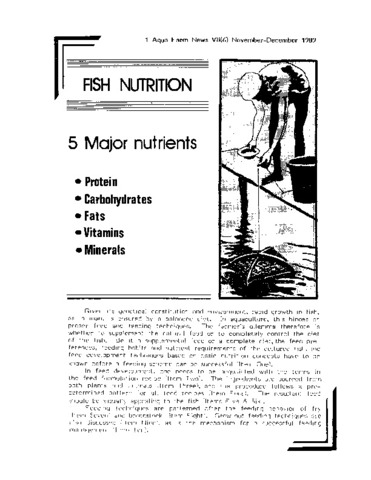| dc.contributor.author | Gabiota, Julius Remar A. | |
| dc.contributor.editor | Quinitio, Emilia T. | |
| dc.contributor.editor | Parado-Estepa, Fe Dolores | |
| dc.contributor.editor | Coloso, Relicardo M. | |
| dc.date.accessioned | 2017-08-25T09:04:47Z | |
| dc.date.accessioned | 2017-08-25T16:33:18Z | |
| dc.date.available | 2017-08-25T09:04:47Z | |
| dc.date.available | 2017-08-25T16:33:18Z | |
| dc.date.issued | 2017 | |
| dc.identifier.citation | Gabiota, J. R. A. (2017). Nursery and grow-out feeding management of mud crab farmers in the Philippines: Santeh experience. In E. T. Quinitio, F. D. Parado-Estepa, & R. M. Coloso (Eds.), Philippines : In the forefront of the mud crab industry development : proceedings of the 1st National Mud Crab Congress, 16-18 November 2015, Iloilo City, Philippines (p. 152). Tigbauan, Iloilo, Philippines: Aquaculture Department, Southeast Asian Fisheries Development Center. | en |
| dc.identifier.isbn | 9789719931072 | |
| dc.identifier.uri | http://hdl.handle.net/10862/3187 | |
| dc.description | Abstract only. | en |
| dc.description.abstract | Mud crab (Scylla serrata) farming has been one of the means of livelihood of many Filipino farmers in coastal areas, specifically in Southern Luzon and Visayas. Nursery and grow-out operations in these areas vary in terms of their feeding management and techniques for a better yield. Farmers in Bicol region, specifically Sorsogon which is one of the sources of wild crablets in the country, are presently using pelleted feeds for nursing different crab sizes. On the other hand, farmers in Quezon, Bataan, Masbate, Negros and Capiz are growing crabs to marketable size for domestic and export markets.
It was noted that there are still farmers in some areas that use low value fish for feeding crabs resulting in the deterioration of the pond bottom and water environment. On the other hand, pelleted feeds serve as an alternative feed that addresses the problem of the declining supply of trash fish, corn, mussel and snails. The price of trash fish has increased significantly due to its unavailability in several areas. In addition, pollution of the water environment and fluctuations in the water parameters for crabs due to improper pond preparation, pollution and climate change have added stress to the crabs. | en |
| dc.language.iso | en | en |
| dc.publisher | Aquaculture Department, Southeast Asian Fisheries Development Center | en |
| dc.subject | Scylla serrata | en |
| dc.subject | Philippines | en |
| dc.title | Nursery and grow-out feeding management of mud crab farmers in the Philippines: Santeh experience | en |
| dc.type | Conference paper | en |
| dc.citation.spage | 152 | |
| dc.subject.asfa | crab culture | en |
| dc.subject.asfa | culture effects | en |
| dc.subject.asfa | deterioration | en |
| dc.subject.asfa | feeds | en |
| dc.subject.asfa | feeding | en |
| dc.subject.asfa | growing ponds | en |
| dc.subject.asfa | juveniles | en |
| dc.subject.asfa | livelihoods | en |
| dc.subject.asfa | marine crustaceans | en |
| dc.subject.asfa | marketing | en |
| dc.subject.asfa | nursery ponds | en |
| dc.subject.asfa | pollution | en |
| dc.subject.asfa | trade | en |
| dc.subject.asfa | yields | en |
| dc.citation.conferenceTitle | Philippines : In the forefront of the mud crab industry development : proceedings of the 1st National Mud Crab Congress, 16-18 November 2015, Iloilo City, Philippines | en |
| dc.subject.scientificName | Scylla serrata | en |



